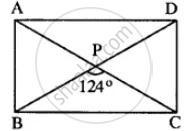Advertisements
Advertisements
प्रश्न
Draw a square whose each side measures 4.8 cm.
उत्तर

\[\text{ (i) Draw side AB = 4 . 8 cm } . \]
\[\text{ (ii) From A, make an angle of 90°and cut it at 4 . 8 cm and mark it point D } . \]
\[\text{ (iii) From B, make an angle of 90° and cut it at 4 . 8 cm and mark it point C } . \]
\[\text{ (iv) Join C and D } . \]
\[\text{ Thus, ABCD is the required square } .\]
APPEARS IN
संबंधित प्रश्न
Two adjacent angles of a parallelogram are (3x − 4)° and (3x + 10)°. Find the angles of the parallelogram.
Which of the following statement is true for a rectangle?
It has all its sides of equal length.
Which of the following statement is true for a rectangle?
Its diagonals are equal and perpendicular, and bisect each other.
A window frame has one diagonal longer than the other. Is the window frame a rectangle? Why or why not?
Find the length of the diagonal of a rectangle whose sides are 12 cm and 5 cm.
Using opposite angles test for parallelogram, prove that every rectangle is a parallelogram.
Diagonals of a rectangle PQRS are intersecting in point M. If ∠QMR = 50° find the measure of ∠MPS.
ABCD is a rectangle, if ∠BPC = 124°
Calculate:
- ∠BAP
- ∠ADP

If the adjacent angles of a parallelogram are equal, then the parallelogram is a ______.
A line l is parallel to line m and a transversal p intersects them at X, Y respectively. Bisectors of interior angles at X and Y interesct at P and Q. Is PXQY a rectangle? Given reason.
